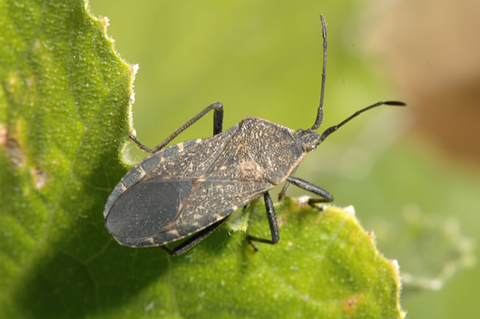Quick facts
- The squash bug is a common pest of squash and pumpkins.
- Young seedlings and plants that are flowering are most vulnerable to squash bug feeding.
- They can cause young plants to wilt and die.
- Squash bugs cause little damage to plants in late summer and fall.
- Squash bugs can be managed through a combination of nonchemical steps and pesticides.
How to identify squash bugs
Adult squash bugs (Anasa tristis) are flattened, large insects.
- They measure 5/8 inch long.
- They are usually dark gray to dark brown.
- Their abdomens have alternating orange and brown stripes.
- The eggs are oval shaped, 1/16 inch long, and yellowish to bronze.
- The nymphs hatching from the eggs range in size from 1/10 to 1/2 inch long as they progress through five stages called instars.
At first, the young nymphs have a light green abdomen and black heads and legs. As the nymphs grow larger, they first turn light gray and then brownish-gray, with black legs and antennae.
Biology of squash bugs
Squash bugs can live through the winter as adults in sheltered places, such as under plant debris, around buildings, or under rocks. When adults come out in the spring, they fly to growing cucurbit plants to feed and mate.
Female squash bugs lay small clusters of eggs (about 20) on the undersides of the leaves, especially between the veins where they form a V. Eggs may also be seen on stems. The females usually start appearing in gardens in early June and continue to lay eggs through mid-summer.
Eggs hatch in about 10 days, and nymphs mature in about four to six weeks. Both adults and nymphs hide under leaves when disturbed.
One generation develops each year, although it is possible that in some summers there is a partial second generation.
The life stages overlap and all of them can be seen at any given time during the growing season. In the fall, especially after the vines have died, the adults and nymphs group together on squash fruits.
The adults fly or crawl to sheltered places for the winter. The nymphs die when temperatures drop to freezing.
Damage caused by squash bugs
Squash bugs primarily attack squash and pumpkins, although they can also attack other plants in the cucurbit family, such as cucumbers.
- They suck the sap out of leaves with their piercing-sucking mouthparts. Their feeding causes yellow spots that eventually turn brown.
- The feeding also affects the flow of water and nutrients, and, when severe, can cause wilting.
- Unlike cucumber beetles, squash bugs do not carry diseases.
- Larger, sturdier plants are more tolerant of feeding damage, while young plants may die because of feeding.
How to protect your plants from squash bugs
Keep your plants healthy
Maintain healthy, sturdy plants through proper fertilization and watering to help limit squash bug damage.
Pick bugs off the plant early
- Early detection of nymphs is important, as adult squash bugs are difficult to kill.
- Remove and kill nymphs and adults by dropping them into a pail of soapy water. This is practical only if a few plants are affected.
- Removal of squash bugs can be challenging because squash bugs hide under leaves and move quickly when disturbed.
- Crush eggs that are attached to the undersides and stems of leaves.
- Trap squash bugs by laying out boards or pieces of newspaper. Squash bugs will group under the boards at night; you can then collect and destroy them in the morning.
- Remove plant debris during the growing season to reduce sites where squash bugs can hide.
- Clean up cucurbits and other plant matter in the fall to reduce the number of overwintering sites.
Using pesticides
Insecticides are normally not required to manage squash bugs. However, if cucurbits are found wilting early in the season due to squash bug feeding, then an insecticide application is probably needed to manage them.
- Target immature nymphs which are more vulnerable to insecticides than adults.
- The insecticides available to home gardeners are generally not effective against adults.
- The best time to apply pesticides is early morning or late at night (during minimum bee activity).
- Be sure to spray underneath the leaves, where most squash bugs are found.
- It is not necessary to treat squash bugs found in the garden during late summer or fall.
- Active ingredients of commonly available pesticides are:
- permethrin
- acetamiprid
- spinosad
- malathion
CAUTION: Mention of a pesticide or use of a pesticide label is for educational purposes only. Always follow the pesticide label directions attached to the pesticide container you are using. Remember, the label is the law.
Be sure that the vegetable you wish to treat is listed on the label of the pesticide you intend to use. Also be sure to observe the number of days between the last pesticide application and when you can harvest your crop (pre-harvest interval, PHI).
Reviewed in 2020







